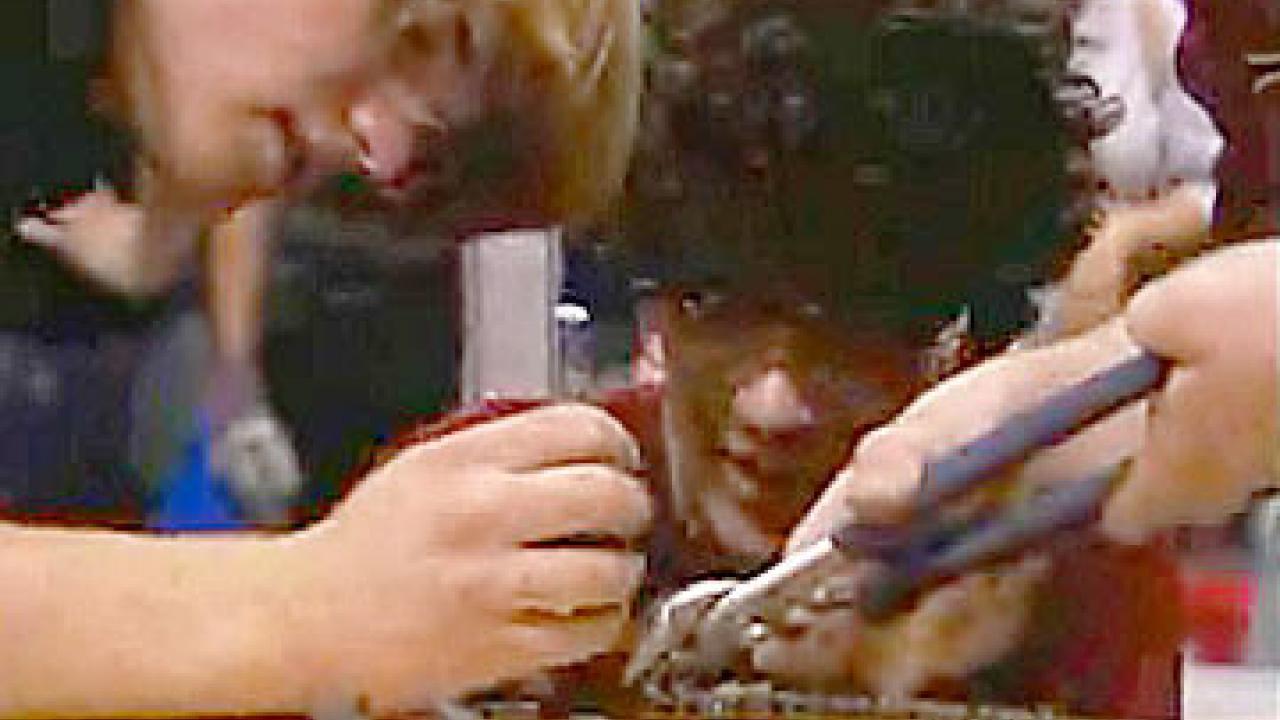Forty-four high school teams and their robots will converge on UC Davis on Friday, March 27, for two days of high-adrenaline games in the Sacramento Regional FIRST Robotics competition.
Free and open to the public, this regional staging of the worldwide competition is being held for the fifth consecutive year at the UC Davis Activities and Recreation Center.
From 9 a.m. to 4 p.m. on Friday and Saturday, students will team with their robotic charges to compete for a range of honors and prizes, college scholarships, and a shot at the FIRST Robotics international championships in Atlanta’s Georgia Dome in April.
Founded in 1989 by Dean Kamen, an entrepreneur and inventor of such innovative devices as the Segway and IBot Mobility System, the competition is designed to introduce and engage high-school students to the fields of science and engineering.
Every year in early January, FIRST organizers unveil a new game that challenges teams of about 15 to 25 students to design and construct remote-controlled mechanical game participants. All teams receive identical kits containing construction materials such as steel plate, polycarbonate sheets, small motors, microswitches, joysticks and single-board computers. (Kit contents are tailored each year to the tasks of that year’s game.) Six weeks later, teams are required to pack their robotic contestants in crates and ship them to the site of their first competition.
Teams at regional competitions are judged on the effectiveness of their robots, their power of collaboration and partnerships, and the spirit and determination of their students. Teams are then rewarded for excellence in robot design, demonstrated team spirit, community involvement, good sportsmanship and camaraderie among teams, and ability to overcome obstacles. Successful teams from regional competitions are invited to the national championship. Winning, however, is not the only way to advance to this stage. After participating for four years in regional competitions, teams qualify to compete at the national event.
This year’s game, dubbed “Lunacy,” commemorates the 40th anniversary of the first moonwalk. Trailer-towing robots are charged with picking up 9-inch game balls and depositing them in trailers hitched to competing robots. Played on a low-friction floor, the tournament forces student designers to devise strategies to deal with the kind of sliding and spinning that vehicles encounter under low-gravity conditions on the moon.
The program accomplishes much more than engaging students in engineering and science, said Northern California regional director for FIRST Robotics Randy Lam, a technology teacher at Monte Vista High School in Danville and a UC Davis alumnus.
“There’s a whole learning and growth experience that focuses around the robot,” he explained. “These kids learn to explore what their strengths and weaknesses are and to recognize limitations. They learn teamwork and how to realistically reach a goal.”
The experience also serves as a practical lesson in time management, budgeting and resourcefulness, Lam added. “Participation in the competition is incomparable to any other experience these kids could have at school. This program really works. These students frequently go on to pursue technological fields at universities around the country.”
The UC Davis venue has been increasing in popularity. This year there will be seven more teams on the floor than in 2008.
“Only one or two of the country’s 40 regional competition sites have longer waiting lists than we do,” said Lam, who attributes the surge in applications not only to rising interest in the competition, but to the reputation that UC Davis has among teams as a friendly, somewhat more relaxed venue than other sites. Tighter travel budgets this year may also have influenced some teams to head to Davis, he said.
This year more than 1,600 teams from 11 countries on four continents will take part in the games. Of the 44 teams arriving in Davis, two are from out of state (from Boise, Idaho, and Lebanon, Ore.) and the others from as far afield as Goleta, Granada Hills and Carmel.
Local high schools sending teams to the competition include St. Francis, Elk Grove, Pleasant Grove, Vacaville, Hiram W. Johnson, and Rosemont, along with two combined teams: Granite Bay with South Placer Area high schools, and Davis Senior with DaVinci High School.
Major sponsors of the regional competition are UC Davis, Abbott Labs Diabetic Division and Chevron Inc.
For more information and a complete schedule of events go to http://firstsac.engineering.ucdavis.edu/.
About UC Davis
For 100 years, UC Davis has engaged in teaching, research and public service that matter to California and transform the world. Located close to the state capital, UC Davis has 31,000 students, an annual research budget that exceeds $500 million, a comprehensive health system and 13 specialized research centers. The university offers interdisciplinary graduate study and more than 100 undergraduate majors in four colleges — Agricultural and Environmental Sciences, Biological Sciences, Engineering, and Letters and Science — and advanced degrees from five professional schools: Education, Law, Management, Medicine, and Veterinary Medicine. The UC Davis School of Medicine and UC Davis Medical Center are located on the Sacramento campus near downtown.
Media Resources
Liese Greensfelder, Research news (emphasis: biological and physical sciences, and engineering), (530) 752-6101, lgreensfelder@ucdavis.edu
Karen McDonald, College of Engineering, (530) 752-0559, kamcdonald@ucdavis.edu
Randy Lam, Monte Vista High School, Danville, (925) 933-0874, lchops@att.net
